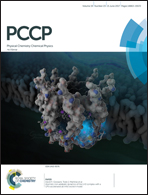A DFT study of the adsorption of glycine in the interlayer space of montmorillonite
Abstract
The adsorption properties of clay minerals have been widely studied in several technological areas, due to their versatility, absorption capacity and catalytic properties. The interaction of amino acids with clay surfaces can be interesting due to their role in prebiotic scenarios. Different degrees of hydration and the adsorption of the glycine molecule and glycinium cation in the interlayer space of montmorillonite were investigated by means of calculations based on density functional theory (DFT). Our calculations show that the cation exchange of K+ by glycinium in the interlayer of hydrated K-montmorillonite is highly possible and exothermic. This supports previous experimental results by explaining the possible adsorption of glycine as a molecule and cation. Glycine is adsorbed in a zwitterionic form in the interlayer without being solvated with water. Besides, glycine and glycinium are highly exothermically adsorbed in the interlayer. The interlayer spacings under different conditions were in agreement with the experimental values. Hydrogen bonds and electrostatic interactions between molecules and surface atoms are responsible for this exothermicity. The IR spectra were calculated and compared with the experimental results showing interesting frequency shifts depending on the intermolecular interactions in the interlayer space of montmorillonite.

- This article is part of the themed collection: 2017 PCCP HOT Articles


 Please wait while we load your content...
Please wait while we load your content...